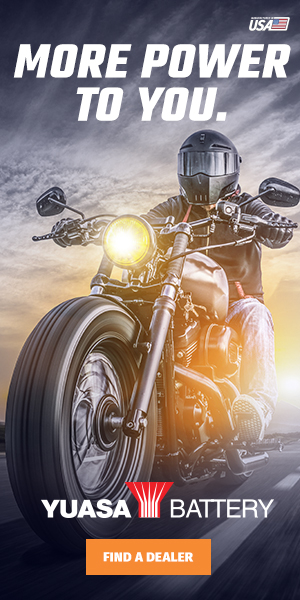hall of fame
KAWASAKI ZX750 TURBO
Turbocharged motorcycles promised big-bike performance—double or even triple the output of a naturally aspirated engine—without big-bike displacement.
From the late 1970s through the mid-1980s, Honda, Kawasaki, Suzuki and Yamaha produced a variety of turbocharged models, with Kawasaki bookending the puffer era with the Turbo Cycle Company-modified Z1R-TC and the swoopy ZX750 Turbo.
Motorcycle magazines teased the 1984 arrival of the ZX750 Turbo, a pristine red, black and gray example of which is displayed in the AMA Motorcycle Hall of Fame museum.
“Kawasaki’s pressure-cooker has performance that the turbo name has up to now only hinted,” Cycle World crowed at the time. “Prototype 750 Turbos have run high-10-second quarter-miles, and posted top speeds in excess of 145 mph.”
Prefacing its November 1983 road test of the ZX750 Turbo, Cycle said, “Turbos were big on bulk, belated on power, long on glitter, and short on completeness. When you tried to string together all of the motions of riding quickly through the mountains, you discovered awkward pauses in the delivery.”
That changed with the ZX750 Turbo. “The K-Turbo simply blows the decals off the other turbos,” Cycle wrote.
Produced for just two years, the boosted E1 and E2 were based on the GPz750.
The air-cooled 738cc inline-four used the donor bike’s bottom end and five-speed gearbox, albeit with revised ratios, with a KZ650 cylinder head, milder-spec camshafts, lower-compression pistons, a beefier clutch and output shaft and digital fuel injection, similar to that found on the GPz1100.
And a Hitachi turbocharger.
The turbo was mounted low and in front of the engine, as close as possible to the exhaust ports, to shorten turbo response time and to keep the associated heat and plumbing away from the rider.
On the Kerker dynamometer that Cycle used, the Turbo made 94.58 horsepower at 9,000 rpm and 62.67 pound-feet of torque at 6,500 rpm.
Chassis-wise, a steel twin-loop frame supported an anti-dive air fork and disc brakes, Uni-Trak single-shock rear suspension and 18-inch wheels.
At the dragstrip, the ZX750 Turbo was, again, according to Cycle, “hallelujah fast and hell for quick.” It cut an 11.13-second quarter-mile with a trap speed of 120.32 mph. “And that makes the ZX one of the strongest stock motorcycles this magazine has ever run between the lights.”
About the ZX750’s road manners, Cycle noted, “Unlike most other turbos, the Kawasaki has almost no lag above 6,000 rpm. The only drawback—if you think it’s one—was defined by one staffer, who observed, ‘The ZX really starts to fly above six grand, but by the time you’ve gone through just two gears (first and second) you’re already going too fast.’”
In its marketing materials, Kawasaki said, “The Turbo is just the beginning.” In reality, it was the end of the turbo era.


